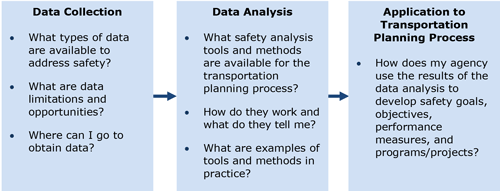
2.0 Audience, Purpose, and Guidebook Structure
2.1 Who Should Use this Guidebook?
Integrating safety in the transportation planning process requires many different considerations, one of which is using qualitative and quantitative analysis to understand the safety issues and trends, identify programs and projects, and evaluate the results. This guidebook will help transportation planners at DOTs and MPOs understand what types of safety data to use and where they can be accessed; analysis techniques to understand the key concerns; and opportunities to use the data and analysis to inform planning decisions. Practitioner examples are included throughout to demonstrate realistic approaches to addressing each of these topics.
2.2 Why the Guidebook is a Useful Tool?
Currently available literature and resources related to safety data, analysis, or planning typically focus on certain components of the process, such as types of safety data or how to use certain analysis tools. This guidebook provides users with a step-by-step approach for putting data and analysis together to inform safety decisions in the transportation planning process. Figure 2.1 demonstrates the type of questions this guidebook will help answer.
Figure 2.1 Flowchart. Guidebook Outline

Source: Cambridge Systematics, Inc.
2.3 Guidebook Components
The guidebook contains background information, strategies, and examples to help transportation planners obtain data, understand safety analysis tools/‌methods, and utilize the results to inform a data-driven transportation planning process. The following describes the contents of the guidebook.
2.3.1 Performance-Based Planning Process
Chapter 3 presents an overview of the performance-based transportation planning process and the opportunities to consider safety when setting goals and objectives, developing performance measures and targets, and identifying programs and projects. Topics addressed are:
- The transportation planning process;
- Considering safety in the transportation planning process; and
- Strategic Highway Safety Plans (SHSP) and how they serve as a resource.
2.3.2 Getting Started with Transportation Safety Planning—Data Collection
Chapter 4 discusses the opportunities to identify and use available data to consider safety during the transportation planning process. Topics addressed are:
- Institutional considerations necessary to initiate and sustain data collection efforts.
- Types of safety data and how they can inform transportation planning.
- Considerations, such as data quality, completeness, gaps, and availability. This also will include a discussion on overcoming potential data limitations to provide planners with ideas to initiate safety planning with limited data.
- Methods in which agencies can obtain data to initiate data analysis.
2.3.3 Safety Analysis Questions and Tools
Chapter 5 discusses the array of tools, methods, or approaches that planners can utilize to analyze safety data for application to the transportation planning process. Topics addressed are:
- Institutional considerations necessary to initiate and sustain safety analysis.
- Planning- and project-level analysis tools and methods and their functionality. With so many available tools and methods, this section focuses on those that are practical, affordable, and easy to use for planners.
- Analysis approaches and their relationships to the transportation planning process, including several examples from MPOs and DOTs.
2.3.4 Applying Safety Data and Analysis to Inform Decisionmaking
Chapter 6 discusses how the outputs of the data analysis can be used to inform the inclusion of safety in the transportation planning process, namely, safety goals, objectives, performance measures, and programs and projects. Topics addressed are:
- Institutional considerations necessary to initiate and sustain transportation safety planning; and
- How to use data and analysis to:
- Develop safety goals and objectives;
- Develop safety performance measures; and
- Identify and prioritize transportation safety programs and projects.



